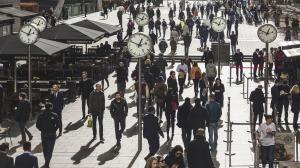
AM and PM Explained
How does the 12-hour clock system work? Is midnight 12 am or 12 pm?
Millions of Orthodox Christians commemorate Good Friday, also known as “Great Friday” to remember the events leading up to Jesus' crucifixion. The Orthodox Easter dates usually differ from the dates used by western churches because most Orthodox churches retained some version of the Julian calendar, which is older than the Gregorian calendar, commonly used today.

The crucifixion and death of Jesus Christ is remembered on Good Friday.
©iStockphoto.com/Richard Goerg
On Good Friday, many Orthodox Christian churches hold special liturgies with readings from the Gospels of the events leading up to the crucifixion of Jesus Christ. In countries such as the United States, some Orthodox churches hold evening liturgies throughout Holy Week, with some special afternoon liturgies for children on Good Friday. Church activities may include: a family retreat with children’s activities; discussion groups; the wrapping of the red eggs to be distributed on Easter Sunday; and a Lenten lunch. Many adult Orthodox Christians observe Good Friday with fasting, prayer, cleanliness, self-examination, confession and good works.
The Greek Orthodox Archdiocese of America celebrates the Passion of Christ, or the last moments of his life according to the New Testament in the Bible, on Good Friday. This liturgy is long, but its content is dramatic. The liturgy also includes participation in prayers and the historical sequence of the events, as related in the Gospels and hymns.
In Greece, Good Friday is a day of mourning so many people may avoid household chores. A ritual lament called the “Procession of the Epitáphios of Christ” mourns the death of Christ on the cross with a symbolic decorated coffin carried through the streets by the faithful. Families attend their church to decorate the Epitaph (Bier of Christ) with flowers. In the morning of Good Friday, Christ’s burial is reenacted in many churches and in the evening the Epitaph procession takes place.
Good Friday is officially observed in countries such as Cyprus, Greece, Lebanon and the Republic of Macedonia. Some embassies are closed in these countries on Good Friday but travelers and expats will need to check first with their own embassies. Many public offices, schools and banks will also be closed.
There are no federal Orthodox Easter public holidays in countries such as Australia, Canada, the United Kingdom, and the United States. However, it is a time for families and friends of the Orthodox Christian faith to gather together and to celebrate the Orthodox Easter period.
In the early Church Good Friday was called "Pascha of the Cross" because it marked the beginning of that Passover. It is part of the Easter period which is observed by both Orthodox and western churches alike, although the Easter dates may differ.
The Council of Nicaea established the Easter date for churches around the world in 325CE but not all Christian churches observed Easter according the Gregorian calendar after it was first introduced in 1582. Many Orthodox churches still observe Easter in accordance with the Julian calendar. Therefore the Orthodox Easter period occurs later than the Easter period that falls around the time of the March equinox.
In the Orthodox circles, tensions exist between New Calendarists – those who use the revised Julian calendar for calculating the feasts of the ecclesiastical year – and Old Calendarists – those who continue to use the traditional Julian calendar. There have been a number of proposed Easter date reforms. In 1997 the World Council of Churches proposed a reform to solve the Easter date difference between churches that observe the Gregorian calendar and those that observe the Julian calendar. So far, this reform has not been implemented.
Good Friday commemorates the moments leading up to and including the crucifixion of Jesus Christ, as told in the New Testament of the Bible. The most common symbols in observing Good Friday are the cross and crucifix and traditions include the venerations of the cross and the preaching or singing of the Passion of Christ.
In Greece, many flags at homes and government buildings are set at half mast to mark the mournful day. The icon of Christ is taken off the cross in churches and is then wrapped in linen and placed in a great casket covered in flowers symbolizing the tomb of Christ. The bier is then taken through the town or village, with people lamenting the death of Christ.

How does the 12-hour clock system work? Is midnight 12 am or 12 pm?

Why do many countries set the clocks back and forth an hour twice a year?

Why are there 12 months? How long are they, and what do the month names mean?

Coordinated Universal Time (UTC) is the basis for civil time today. This 24-hour time standard is kept using highly precise atomic clocks combined with the Earth's rotation.